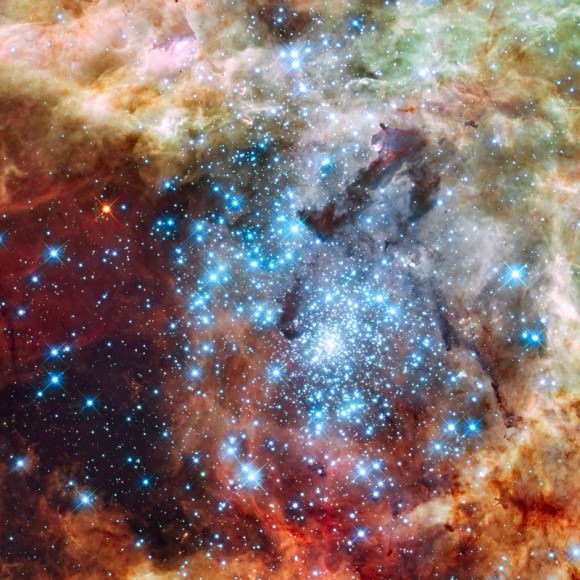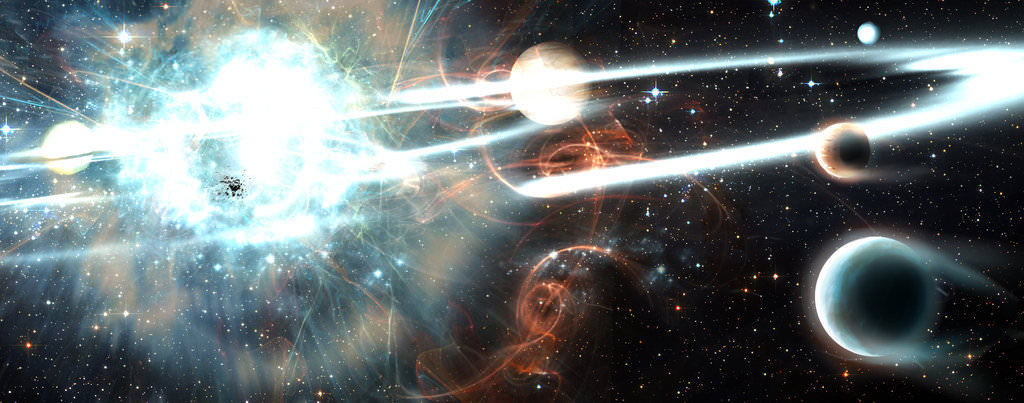Hypervelocity stars have been observed traversing the Galaxy at extreme velocities (700 km/s), but the mechanisms that give rise to such phenomena are still debated. Astronomer Thomas M. Tauris argues that lopsided supernova explosions can eject lower-mass Solar stars from the Galaxy at speeds up to 1280 km/s. “[This mechanism] can account for the majority (if not all) of the detected G/K-dwarf hypervelocity candidates,” he said.
Several mechanisms have been proposed as the source for hypervelocity stars, and the hypotheses can vary as a function of stellar type. A simplified summary of the hypothesis Tauris favors begins with a higher-mass star in a tight binary system, which finally undergoes a core-collapse supernova explosion. The close proximity of the stars in the system partly ensures that the orbital velocities are exceedingly large. The binary system is disrupted by the supernova explosion, which is lopsided (asymmetric) and imparts a significant kick to the emerging neutron star. The remnants of supernovae with massive progenitors are neutron stars or potentially a more exotic object (i.e., black hole).
Conversely, Tauris noted that the aforementioned binary origin cannot easily explain the observed velocities of all higher-mass hypervelocity stars, namely the B-stars, which are often linked to an ejection mechanism from a binary interaction with the supermassive black hole at the Milky Way’s center. Others have proposed that interactions between multiple stars near the centers of star clusters can give rise to certain hypervelocity candidates.

There are several potential compact objects (neutron stars) which feature extreme velocities, such as B2011+38, B2224+65, IGR J11014-6103, and B1508+55, with the latter possibly exhibiting a velocity of 1100 km/s. However, Tauris ends by noting that, “a firm identification of a hypervelocity star being ejected from a binary via a supernova is still missing, although a candidate exists (HD 271791) that’s being debated.”
Tauris is affiliated with the Argelander-Institut für Astronomie and Max-Planck-Institut für Radioastronomie. His findings will be published in the forthcoming March issue of the Monthly Notices of the Royal Astronomical Society.
The interested reader can find a preprint of Tauris’ study on arXiv. Surveys of hypervelocity stars were published by Brown et al. 2014 and Palladino et al. 2014.


Cool – as long as no civilization ever turns it into a weapon of war, or someone happens to be in the way. Now wouldn’t that be an operation of a super-advance civilization – find the binaries that could and engineer them to do it in a safe direction!
Or even better: explore the galaxy this way… by taking your planet with you 😉
A certain number of hyper velocity stars that have reached galactic escaped velocities have occurred from their close encounter with the super massive black hole at the center of our galaxy. But I would suppose that a few could indeed be the surviving star of a binary system where both stars were orbiting each other really closely. The key here is not to make an all or nothing assumption. Most likely is that a few came to exist because of a supernova explosion and a few from a close encounter with our galactic center’s super massive black hole. I highly doubt that it’s an all or nothing scenario.
Once these events are viewed as electromagnetic events then the “mystery” around them will vanish.
As for neutron stars, has anyone ever shown that two neutrons can exist side by side in the laboratory? Not a chance.
For these ridiculous gravity based theories to be correct, all the laws of chemistry and physics must break down.
I’m not willing to accept that without observations that can be experimentally verified. Black holes, neutron stars and dark matter/energy all have never been observed or experimentally confirmed. Yet people still create new theories based on their existence. Adding one wrong theory on the back of another unproven theory and that’s what results : a paradigm that is full of contradictions and requires the known laws to break down. Beautiful.
When will cosmology hold itself to the same scientific standards that the rest of the scientific world does??
i agree with your “on the back of another unproven theory” premise, but you don’t seem to be able or willing to hold your own theories to the same standards of judgement.
The conditions of the center of the Earth have never been replicated in laboratory either. Do you therefore claim that the Earth has no center?
Of course btraymd ignores any experimental or observational evidence that conflicts with his bizarre theory, but will pop up on new stories to spout the same vague, self-contradictory crap. He’s already fled from me in three threads on this site, where I pointed out EU predictions that turned out completely wrong.
I’ve been reading up on the EU theory, and it really is very bizarre and stupid. Did you know that they think space shuttle Columbia was struck by “super-lightning”? Ridiculous. And their explanation for the Bullet Cluster is to postulate that it’s actually really close to us but made of teeny tiny little galaxies where for some reason we cannot resolve the individual stars even though they claim it to be within the Local Group. This is the kind of crap EU people believe, so I hope people don’t get fooled into believing there’s any kind of plausibility to their dogma just because some EU spammer comes here saying vague things like “Planck found a magnetic field, therefore we’re right”.
To the contrary, I have found the recent theories by plasma physicists with working with magnetism (see the “Primer Fields”) to be based on observations that have been confirmed in the laboratory. Their findings mirror the nebula and galaxy formations being newly observed by the Hubble.
The massive electric currents predicted to be flowing through the galaxy have recently been confirmed by the Planck radio telescope data. The accompanying galactic sized magnetic fields have also been confirmed by the Planck.
It’s time this new evidence be examined carefully and the theories of an electromagnetically driven cosmos be re-examined.
These theories make common sense, have an observable basis and experimental research is confirming their validity. Reminds me of actual science!
I think I know why EU proponents often encounter some hostility (or at least snarky comments).
I like to be open minded and allow competing theories. I even liked one of the lab tests sighted in a youtube EU video explaining an experiment that replicated the shape of spiral galaxies using field charges. However another theory that the sun’s corona temp of 2million C was due to electric fields connected to other bodies. I find it kooky.
Back to the reason many here tire of EU theory: Newton supplied laws which could be tested falsified and used for simulating and explaining our natural world. Ditto Einstein with description of the photoelectric effect and formulas for GR and SR…
What does EU theory supply? Youtube videos long on anecdote and story telling but short on supplying laws, formulas which can be tested or used to formulate predictions… Can’t plug that into any computer simulation or lab experiment.. So it is just conjecture and not hypothesis and certainly not theory.
The amount of knowledge to be had is awesome. We were made to learn and we’re doing a nice job of it. However, some put it to bad use.
Please do NOT refer btraymd “s comments as EU …. That is an Insult to the European Union (EU) … btraymd fell out of the pram when he was a child and landed on his head since then all his comments are SHOCKING!!! 🙂